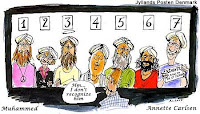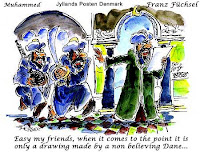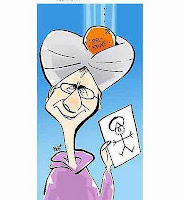Wednesday, January 7, 2015
Charlie-Hebdo...
Charlie-Hebdo... The appalling news out of Paris this morning, about the terrorist attack that has killed 12 people at the offices of the satirical French newspaper, immediately made me think of the success the terrorists likely will have in their larger goal: silencing the critics of Islam. True to my concern, progressives both here in America and in Europe are already busy blaming the victims – and most definitely not defending free speech.
I'd rather die standing than live on my knees (via Mark Steyn)
First-hand account from the terrorist attack on Charlie-Hebdo (Claire Berlinski)
Charlie-Hebdo massacre: how the west will respond (James Delingpole)
Do not submit! (Zombie)
Here are some links to the best things I've read so far. In the last piece, “Zombie” calls out for publishing the “offensive” cartoons far and wide. Zombie is right: we need to assert our free speech rights vigorously. We cannot appease these monsters. We must resist. To that end, I'm republishing the original cartoons that provoked so much manufactured outrage amongst radical Muslims. I first published these almost 9 years ago, in February 2006...












I'd rather die standing than live on my knees (via Mark Steyn)
First-hand account from the terrorist attack on Charlie-Hebdo (Claire Berlinski)
Charlie-Hebdo massacre: how the west will respond (James Delingpole)
Do not submit! (Zombie)
Here are some links to the best things I've read so far. In the last piece, “Zombie” calls out for publishing the “offensive” cartoons far and wide. Zombie is right: we need to assert our free speech rights vigorously. We cannot appease these monsters. We must resist. To that end, I'm republishing the original cartoons that provoked so much manufactured outrage amongst radical Muslims. I first published these almost 9 years ago, in February 2006...












Croque madam...
Croque madam... We had croque madam (with Emmental cheese) this morning for breakfast, at Crumb Brothers. It will make your brains fall out. Word.
On the way home it was just before sunrise. Debbie took the photo at right through our truck's window as we were heading south toward Paradise. The mountains are the Wellsvilles, looming over the town of Wellsville...
On the way home it was just before sunrise. Debbie took the photo at right through our truck's window as we were heading south toward Paradise. The mountains are the Wellsvilles, looming over the town of Wellsville...
Miki's new boots...
In the cold snap we had last week, we noticed that our dogs – especially the field spaniels – were uncomfortable walking in the very cold snow. They'd want to come back inside after just a few minutes, and they acted like their feet were painful. After a little research, we discovered that several manufacturers make dog boots for exactly this problem. We tried a set first for Race (our border collie), figuring that if they stayed on his narrow feet, then they'd work for all the dogs. They worked great, and Race got used to them in just a few seconds. So we ordered another set, big enough for the field spaniels and their wider, fuzzier feet. I put them on Miki to try out for fit, and they fit great.
What we didn't expect was Miki's comical reaction to the new boots, as you can see in the video. We were laughing for hours after his first adventure with his new boots. We'll probably try them again today. I suspect it's going to take him a few attempts to get comfortable with them. Meanwhile, he'll give us a few belly laughs :)
We're paperless!
We're paperless! This has been a dream – well, fantasy, really – of mine since the earliest days of hobbyist microcomputers in the early '70s. It took forty years, but I finally am able to say that I have an entirely practicable way for us to have a paperless office here at home.
What exactly do I mean by “paperless”? Mainly I mean that we can simply throw away (or shred) nearly every bit of paper that comes into our life: receipts, invoices and bills, and even official records. The only exception, really, is paperwork that has original signatures or seals – quite uncommon, these days. Everything else gets scanned, converted to text (through Optical Character Recognition, or OCR), and indexed. Whenever I need to see a document, I simply search for it – just like googling the web. If I need a physical copy, I simply print it. An electronic copy (in PDF form) I can just export.
Several technologies had to reach a sufficient threshold to make this feasible:
We bought a Fujitsu ScanSnap iX500 scanner (about $500), and DEVONthink's document management software ($169). The software is running on my MacBook Pro, which has plenty of storage for this purpose. The only other important component is a shredder, for getting rid of paper documents with confidential information on them.
The first photo below shows the scanner, all folded up when not in use. In the second photo, you see the scanner unfolded (which automatically turns it on) and ready to scan a document. To scan, you just push the brightly lit blue button. The document scans (both sides!) in about one second. It can feed dozens of pages at once, and any size paper up to about 9" wide. The scan is in full color, with a variable resolution automatically selected by the scanner. Once the document is scanned, one click sends it to the document management software after being converted to text (by OCR). There, one click stores it in whatever folder you want it in.
That's it. You're done. Shred the document!
When you actually need a document, you can simply search for it. The last image below shows the result of my searching for "romaine". I typed that word into the search box in the upper right corner of the document manager, just like I might search the web. The results show up as a list of documents, ranked by how close the match was. In this case I had only a single matching document, so figuring out which one I wanted was easy :) In other cases, I'll get a list of documents, and the file name contains the date. I can click on any document in the list, and the match is instantly displayed on the screen, scrolled to the matching text.
I don't know how it could be any easier. The entire process is way easier than filing, which is what it needs to be for it to be attractive to me.
The document manager has far more capabilities than I've explored, and someday – maybe – I might go take a look at them. The one thing I can think of that I'd like is a way to eliminate a couple of those clicks I make now after scanning. Ideally, I'd push that blue button on the scanner and everything else would be automatic. But if it can't do that, it's not a big deal – those few clicks are far less work than physically moving the piece of paper to the “right” file folder...
I'm starting to feel like the future has finally arrived. Now, where's my flying car?
What exactly do I mean by “paperless”? Mainly I mean that we can simply throw away (or shred) nearly every bit of paper that comes into our life: receipts, invoices and bills, and even official records. The only exception, really, is paperwork that has original signatures or seals – quite uncommon, these days. Everything else gets scanned, converted to text (through Optical Character Recognition, or OCR), and indexed. Whenever I need to see a document, I simply search for it – just like googling the web. If I need a physical copy, I simply print it. An electronic copy (in PDF form) I can just export.
Several technologies had to reach a sufficient threshold to make this feasible:
- Storage (disk, rotating and solid state) had to be cheap enough to make storing the big files that result from scanning practicable. Storage reached this point almost ten years ago.
- Scanners had to be capable of high resolution color scanning of both sides of any size of paper, quickly, easily, and reliably. Paper handling, in particular, needed to improve dramatically over the scanners of the '90s. Several manufacturers started making scanners that met all the requirements, at affordable prices, about five years ago.
- Optical Character Recognition (OCR) had to be good enough to successfully convert the vast majority of scanned text – no matter how bad the scan, or what crazy font was being used. The receipts printed by cash registers have long been the canonical example of common, hard to OCR documents. To improve as needed, OCR software had to get better, and home computers had to have sufficient power and memory for them to work. OCR software reached this point a few years ago.
- Document management software had to get both more powerful and yet be simple enough for casual users to be able to handle it. It also had to be inexpensive enough that a consumer might afford it. I first started reading about such software about a year ago.
We bought a Fujitsu ScanSnap iX500 scanner (about $500), and DEVONthink's document management software ($169). The software is running on my MacBook Pro, which has plenty of storage for this purpose. The only other important component is a shredder, for getting rid of paper documents with confidential information on them.
The first photo below shows the scanner, all folded up when not in use. In the second photo, you see the scanner unfolded (which automatically turns it on) and ready to scan a document. To scan, you just push the brightly lit blue button. The document scans (both sides!) in about one second. It can feed dozens of pages at once, and any size paper up to about 9" wide. The scan is in full color, with a variable resolution automatically selected by the scanner. Once the document is scanned, one click sends it to the document management software after being converted to text (by OCR). There, one click stores it in whatever folder you want it in.
That's it. You're done. Shred the document!
When you actually need a document, you can simply search for it. The last image below shows the result of my searching for "romaine". I typed that word into the search box in the upper right corner of the document manager, just like I might search the web. The results show up as a list of documents, ranked by how close the match was. In this case I had only a single matching document, so figuring out which one I wanted was easy :) In other cases, I'll get a list of documents, and the file name contains the date. I can click on any document in the list, and the match is instantly displayed on the screen, scrolled to the matching text.
I don't know how it could be any easier. The entire process is way easier than filing, which is what it needs to be for it to be attractive to me.
The document manager has far more capabilities than I've explored, and someday – maybe – I might go take a look at them. The one thing I can think of that I'd like is a way to eliminate a couple of those clicks I make now after scanning. Ideally, I'd push that blue button on the scanner and everything else would be automatic. But if it can't do that, it's not a big deal – those few clicks are far less work than physically moving the piece of paper to the “right” file folder...
I'm starting to feel like the future has finally arrived. Now, where's my flying car?
Calendars and clocks...
Calendars and clocks ... they bring out the stupid. Check out this thread on a body-building forum for an outstanding example.
I once had a job at an electronic stock and option trading company, which was run by a very smart fellow with decades of experience. He and I once had a three hour debate about how time zones worked – he didn't believe it was true that at given moment there are either two or three dates, depending on where you are on the planet (the two dates occurs because of the international date line; the three dates possibility occurs for a more obscure reason – some very odd time zones in the Pacific Ocean islands). It didn't matter that I could give him articles, books, and even scientific papers discussing the phenomenon. Nothing I did could convince him, and because of that he wouldn't let me fix a bug in our software that affected traders operating from those aforementioned Pacific Ocean islands.
But at least he understood that there were seven days in a week, unlike one fellow on that thread!
I once had a job at an electronic stock and option trading company, which was run by a very smart fellow with decades of experience. He and I once had a three hour debate about how time zones worked – he didn't believe it was true that at given moment there are either two or three dates, depending on where you are on the planet (the two dates occurs because of the international date line; the three dates possibility occurs for a more obscure reason – some very odd time zones in the Pacific Ocean islands). It didn't matter that I could give him articles, books, and even scientific papers discussing the phenomenon. Nothing I did could convince him, and because of that he wouldn't let me fix a bug in our software that affected traders operating from those aforementioned Pacific Ocean islands.
But at least he understood that there were seven days in a week, unlike one fellow on that thread!
Subscribe to:
Comments (Atom)





